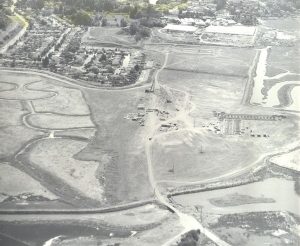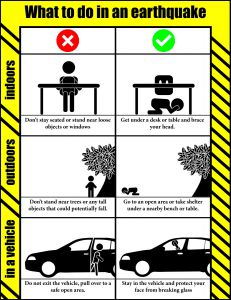On the morning of April 18, 1906, a massive earthquake shook San Francisco, California. While the quake lasted only 60 seconds, it left an unforgettable mark on history.

Every day, the Bay Area is struck with one or more earthquakes, and while the quakes only average around a magnitude of 2.5, a USGS survey states that there is a 32 percent chance that an earthquake of a 6.7 magnitude or higher will strike Marin County residents before 2030.
Recently, a relatively local earthquake rolled through Napa Valley at a 6.0 magnitude, creating slight tremors throughout Marin County.
Geologically, Redwood High School sits mostly on loose soils, which would result in devastation if struck by an earthquake of magnitude of 6.7 or higher, according to Carl Wilford, an earthquake engineer.
Wilford says Redwood’s main academic building was originally constructed on marshland that was leveled and filled prior to its construction in the late 1950s.
The school is surrounded by loose soil and marshlands, known as a liquefaction zone; liquefaction is the process by which loose soil or sand is converted into a suspension during an earthquake.
When liquefaction occurs, the soil becomes weaker, and its ability to support foundations of buildings and bridges is reduced. In the event of an earthquake over a magnitude of 6.0, Highway 101 in Marin would suffer from liquefaction, causing it to collapse, similar to what happened to the Marina District in San Francisco during the 1906 quake.
The Redwood campus might have a similar outcome in the event of an earthquake over a magnitude of 6.0, according to Michael Skyler, founder of the Earthquake Supply Center in San Rafael. The places closest to the liquefaction zone, such as the lacrosse fields, would cave in. If the Earth’s surface were to shake rapidly on loose soil, the field would split, creating a large divide.
Softer soils amplify the amount of earthquake shaking.
“An above-ground pool would probably collapse because it’s going to shake so much that the ground isn’t going to support it,” Skyler said. “If it’s just on sand or marshland it’s okay if the Earth isn’t moving, but once the Earth starts moving, then all the supports will disappear.”
Redwood’s main gym would also have a high risk of collapsing due to the lack of a stable center, Skyler said.
“It is such a big space that it would collapse. There are no support beams in the center, so it is just open space on landfill,” he said. Due to the power of a larger quake, open areas would suffer more.
“There is probably less steel reinforcing the concrete walls than there would be in modern buildings, which could result in more severe cracking in walls, especially around window openings,” Wilford said. “No one can say with certainty the amount of earthquake damage that would occur in any structure, but I believe the relatively new small gym should withstand a significant seismic event without major damage.”
Wilford added that no building is truly earthquake “safe,” but a well-designed structure would be better suited to survive an earthquake.
Interactive map by Olivia Dominguez and Kaylee Bushell
There are multiple factors that determine the amount of damage caused. According to Skyler, the location of the fault determines the amount of shaking. If the quake occurred from the San Andreas Fault, the shaking would be dramatically less than if the quake originated at the Hayward fault, which runs for about 74 miles along the Western base of the hills on the East side of the San Francisco Bay.
Redwood would be tremendously affected by the Hayward fault because there hasn’t been a large earthquake on the northern part of the Hayward in the last 300 years, and the recurrence interval is about one every 210 years, according to the USGS survey.
The Hayward fault slices through densely populated areas, including the cities of Richmond, El Cerrito, Berkeley, Oakland, San Leandro, Hayward, Fremont, and San Jose.
According to Earthquake Safety, a Bay Area organization that prepares individuals houses for earthquakes, the next quake in northern California will most likely transpire along the Hayward Fault. A 6.7 quake has a 31 percent chance of occurring on the Hayward Fault in the next 30 years, while the San Andreas Fault holds a probability of 21 percent. The reason for this is because there hasn’t been a large quake on the Hayward in ages, so the tension is building.
The 1906 earthquake was caused by the San Andreas Fault shifting over a segment about 275 miles long, and the subsequent shock waves could be felt from Oregon to Los Angeles.
According to USGS, there have only been 12 “big” earthquakes in the Bay Area between 1906 and 2000, a lower number than in previous years, tallying up with an average magnitude of 5.5 and up.
Directly following the 1906 earthquake, the fault stresses were reduced, along with the rate of large quakes in the Bay Area, but now, according to USGS, the plates are straining, creating stress on the Bay Area faults.
“Since more years have gone by, the probability is rising,” Skyler said. “We are overdue and are going to have one, but we just don’t know exactly when.”
With the increasing probabilities of future Earthquakes in the Bay Area, only a few around the community are taking the certain safety precautions.
Earthquake Preparedness
According to the USGS fewer than 50% of families in Marin carry emergency supply kits, and as a result, are unprepared in the event of an earthquake.

“It’s an act of wisdom to get prepared” Skyler said. “People think it will be okay because they have never had a problem with it. That’s the mistake they make.”
During the first 72 hours after an earthquake or any natural disaster, having emergency supplies is critical because bridges and roads used to transport food and water may be damaged from the disaster.
According to Skyler, many people don’t realize that while having emergency supplies at home is essential, the most important place to keep supplies is in the car.
A standard emergency supply kit can be purchased for around $80, but with proper instruction, people can assemble their own.
Get Ready Marin, a county sponsored program that offers disaster preparedness training, recommends that a kit should contain supplies for around three days. For each additional person that the kit must supply for, essential items like food and water should be doubled.
Skyler states that a standard supply kit should contain food bars, water pouches, a flashlight, a radio, batteries, emergency blankets, light sticks, body warmers, a whistle, toilet paper, trash bags, a pocket knife, dust masks, a safety vest, waterproof matches, gloves, pencils and paper, a First Aid guide, a First Aid kit, and a hygiene kit.
Each classroom at Redwood contains a class set of supplies equipped with food and water to last a class of thirty students for just one day.
According to Skyler, the most commonly forgotten supplies are the nonessential but important hygiene supplies.

“Self-esteem is important at that point, [so] that you don’t let the emergency defeat you.” Skyler said.
Home emergency supply kits should be stored at the front or back of a house near a door, making it easy to grab while leaving the house.
Since earthquakes are unpredictable, families are recommended to establish a safe meeting place to go to in case they become separated. The USGS states that it is important that all family members know these meeting places so that in times of turmoil and disruption, families can find each other.
According to Redwood’s assistant principal LaSandra White, the Redwood campus is a go-to place during a disaster. From an agreement between the district and the Red Cross, anyone in the area can come to the Redwood campus for supplies and a safe place to take shelter.







